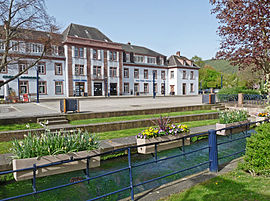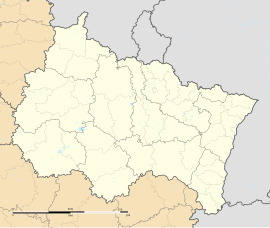You can help expand this article with text translated from the corresponding article in French. (December 2008) Click [show] for important translation instructions.
|
Niederbronn-les-Bains (French pronunciation: [nidəʁbʁɔn le bɛ̃]; German: Bad Niederbronn) is a commune in the Bas-Rhin department in Grand Est in north-eastern France.[3] It is positioned between Bitche and Wissembourg, close to the current frontier with Germany.
Niederbronn-les-Bains | |
|---|---|
 Former De Dietrich central office and Falkensteinerbach river | |
| Coordinates: 48°57′N 7°38′E / 48.95°N 7.64°E | |
| Country | France |
| Region | Grand Est |
| Department | Bas-Rhin |
| Arrondissement | Haguenau-Wissembourg |
| Canton | Reichshoffen |
| Government | |
| • Mayor (2020–2026) | Anne Guillier[1] |
Area 1 | 31.4 km2 (12.1 sq mi) |
| Population (2021)[2] | 4,360 |
| • Density | 140/km2 (360/sq mi) |
| Time zone | UTC+01:00 (CET) |
| • Summer (DST) | UTC+02:00 (CEST) |
| INSEE/Postal code | 67324 /67110 |
| Elevation | 180–577 m (591–1,893 ft) (avg. 192 m or 630 ft) |
| Website | Official website |
| 1 French Land Register data, which excludes lakes, ponds, glaciers > 1 km2 (0.386 sq mi or 247 acres) and river estuaries. | |
Niederbronn-les-Bains is part of the Northern Vosges Regional Natural Park. It has a tradition as a spa town, and continues to attract tourists and other visitors needing to recuperate.
History
editNiederbronn-les-Bains was founded in 48 BC when the Romans discovered the healing properties of the local water. The earliest bathing place was in or near the location now occupied by the town's casino. During the fifth century the little town fell victim to the violence that accompanied the period of intense migrations that followed the disappearance from the western empire of Roman governance.
Population
edit| Year | Pop. | ±% p.a. |
|---|---|---|
| 1968 | 4,401 | — |
| 1975 | 4,455 | +0.17% |
| 1982 | 4,446 | −0.03% |
| 1990 | 4,372 | −0.21% |
| 1999 | 4,319 | −0.14% |
| 2007 | 4,421 | +0.29% |
| 2012 | 4,327 | −0.43% |
| 2017 | 4,404 | +0.35% |
| Source: INSEE[4] | ||
Economy and tourism
editThe commune incorporates two mineral water springs, one of them, first exploited more than two thousand years ago, known as the Roman Spring and the other known as the Celtic Spring: Celtic Spring branded water is widely available in the area. The waters' curative properties are recommended against rheumatism and degenerative illnesses. The spa tradition today supports a more general tourist industry in the little town, which even boasts its own casino.
The little town also contains an archaeological museum containing remnants of North Vosgean settlements.
The strategic importance, during the Second World War, of the Wissembourg Gap is reflected in the approximately 15,403 buried in the war cemetery. More than 95% of these were German soldiers, but other nations and civilians are also represented here.
A meeting place called the Albert Schweitzer Centre was set up in 1993 to foster contacts between French and German young people.
Other nearby attractions in the area include the ruined Wasenbourg and the look-out tower on the Grand Wintersberg, some four kilometers to the north.
Notable residents
edit- Suzanne de Dietrich, the Protestant theologian, was born in Niederbronn-les-Bains in 1881 (when the entire area was part of Germany).
- Alphonse-Marie Eppinger, the Catholic founder of the Sisters of the Divine Redeemer, was born in Niederbronn-les-Bains in 1814.
See also
editReferences
edit- ^ "Répertoire national des élus: les maires". data.gouv.fr, Plateforme ouverte des données publiques françaises (in French). 2 December 2020.
- ^ "Populations légales 2021" (in French). The National Institute of Statistics and Economic Studies. 28 December 2023.
- ^ INSEE commune file
- ^ Population en historique depuis 1968, INSEE



